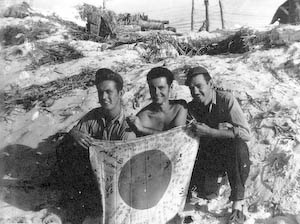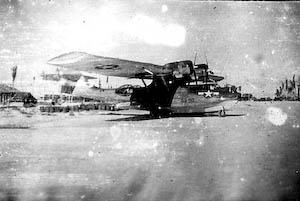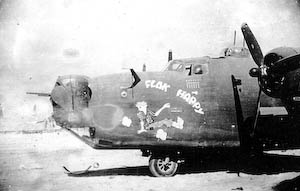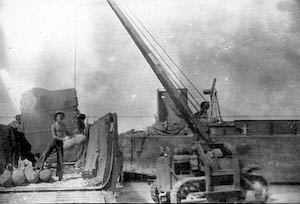When the squadron is formed on the CASUs field, the squadron complement is made up of both flight crews and ground crews. The CASU trains the groundmen in how to work together to keep the planes in good operating condition, and then sets the squadron loose to carry itself through the necessary training prior to its shipment overseas to the combat area. Then the CASU is again free to organize more squadrons.
For the sake of clarity, it must be pointed out that when the squadron is formed it is made up of both flight crews and groundmen. When the squadron embarks onboard its aircraft carrier, the groundmen depart from the squadron and become integral with the ship’s company, going into the air department of the ship. Thus the squadron is completely streamlined, possessing only its aircraft, pilots and aircrewmen.
 Now for the third group. Basically, it is the same as all the other CASUs. However, its primary function differs in that it maintains all types of the Navy’s aircraft in large aircraft pools to use for replacements. Once in a great while they must maintain operating squadrons in addition to their primary duty, but still their main job is furnishing aircraft completely combat ready to the fleet.
Now for the third group. Basically, it is the same as all the other CASUs. However, its primary function differs in that it maintains all types of the Navy’s aircraft in large aircraft pools to use for replacements. Once in a great while they must maintain operating squadrons in addition to their primary duty, but still their main job is furnishing aircraft completely combat ready to the fleet.
These aircraft are brought to the CASU’s field, usually in or very near the forward combat area, by the smaller, or Jeep, aircraft carriers. The airplanes are completely “pickled,” or preserved, in the United States or Pearl Harbor prior to their shipment. They are unloaded from the aircraft carriers onto large pontoon barges and ferried to the air strip, where the CASU takes over.
Immediately the planes are sprayed and the preservative compound removed from all parts of the planes’ engines and structures. Then the technicians take over.
They check the aircraft from the propeller hub to the tail wheel, making repairs and replacements they find necessary. Ordnancemen check all guns, turrets, bomb racks and mechanism, and boresight the guns to the designated pattern.
When these men are through, the test pilot takes over and runs the plane through a comprehensive test flight. Upon his return, a trouble-shooter crew immediately corrects any discrepancies noted by the pilot in flight and the ship is then turned into the pool, ready for issue to the next squadron or aircraft carrier that arrives needing that type of airplane.
Once the airplanes are put in the “ready for issue” pool, a comprehensive system of operation is set up in order to maintain them in the very top operating condition. As all good mechanics know, an engine must be exercised to keep it in good condition. To do this, a system is usually set up in the CASUs where all engines are pulled through several revolutions at least once a day and are turned up, or run up, every other day.
In the same train of thought, an aircraft itself, as with any other mechanical object, must also be exercised to maintain its top condition. To this end, the CASUs as well as any other Naval Aviation organization, fly their aircraft at least once a week. The CASUs have test pilots to do this and to run the preliminary test flight after the de-preserving process.
When originally organized, the CASU was set up to handle carrier type of aircraft only, hence the name Carrier Aircraft Service Unit. However, in the forward areas the CASUs found themselves working on all types of aircraft, even working on some of the Army’s fighters and bombers. Recently, the CASUs of the forward areas had their designations changed to Combat Aircraft Service Unit (F), the “F” standing for Forward. In the same shift, some of the PATSUs had their designations changed to CASU(F).
 In speaking of Naval Aviation, no mention of a CASU can ever be made without mentioning the CASU’s big brother the Acorn.
In speaking of Naval Aviation, no mention of a CASU can ever be made without mentioning the CASU’s big brother the Acorn.
When first conceived, the CASU was a complete unit in itself in that it had all the men and material to completely set up an operating air station on some island in the forward combat area. This system proved itself very well, but many headaches arose in the execution of the duties of maintaining an airfield, setting up and maintaining living quarters and messing facilities, keeping all trucks, jeeps, and other rolling stock in operation. All this in addition to the upkeep and maintenance of aircraft on the air strip. Further, while the CASU’s mobility proved itself to be far greater than the old squadron system, when it came to island hopping the CASU offered many of the old headaches encountered under the squadron system.
The war had hardly more than gotten underway, when the idea of an Acorn was brought forward. Immediately Acorns were formed. They undertook the responsibility of setting up and maintaining the airfields on the scattered Pacific islands almost as fast as they were wrested from the hands of the Japanese. Further, they handle the supply-packaging, loading, and unloading of all the gear necessary for operation of the air strip as well as the aircraft parts necessary to repair the planes that will be based on the air strip.
Thus the CASU was streamlined down to the point where the squadrons found themselves when their groundmen were taken away. Composed only of personnel Officers and men and hampered only by the carrying of their personal effects, the CASU found itself to be highly mobile, just what the Navy wanted when it started out. Island hopping proved to be very easy they could be on their way to a new station as fast as they could drop their tools.
In the original forming in the United States, the CASU and the Acorn are formed together and train together. While the Acorn personnel are learning how to disembark and unload from ships and how to set up an advance base, the CASU is already operating from an air strip, letting the officers and men get the feel of working together before they are called upon to operate on an air strip under the very nose of the Japanese Navy. In addition, all personnel are given hand to hand combat training. There is no telling when such training will come in more than handy at their new base overseas.
The men that come to the new CASUs come from all over the Navy. Some are drawn from the fleet, others are recent graduates of the Navy’s many technical schools on specialized aviation subjects, while others are boots fresh from the training stations. Many, both officers and men, are well seasoned in the work in Naval Aviation enough of them to guarantee that each CASU will be a smooth running organization when it leaves the States.
When the final day comes, the CASU and the Acorn are loaded usually on the same ship the Acorn with all the necessary gear or equipment to set up operation sand they head for their new base, which possibly at that very moment is being methodically taken away from the Japs.
Upon arrival at their destination, the Sea Bees set to work building the air strip and setting up living quarters. A great many times the Sea Bees have already arrived and have the strip well underway or practically completed. In any case, the Acorn disembarks and proceeds to set up operations. Usually the CASU goes along to help in order to speed up the work because they will have no aircraft to work on until the air strip is completed.